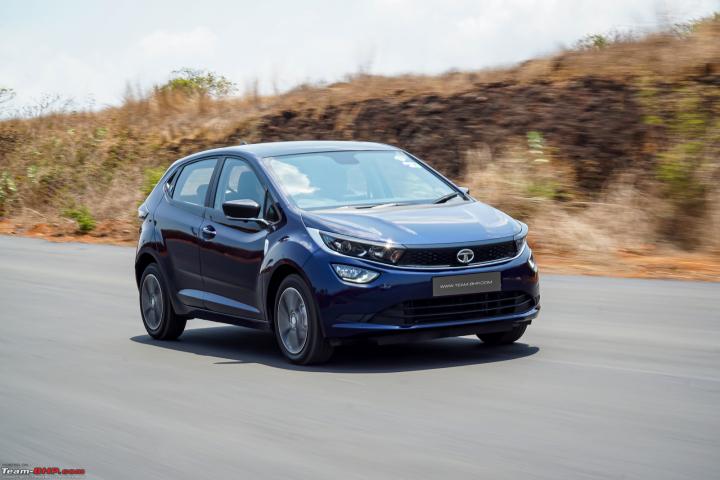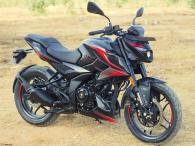News
Tata Altroz CNG : Our observations after a day of driving
Thereâs enough pep on tap for city driving and you can easily keep up with the traffic and close gaps to the cars in front.
Driving the Tata Altroz 1.2L CNG
The Altroz CNG is powered by a 1.2-litre, 3-cylinder Revotron petrol engine that makes 73 BHP @ 6,000 rpm and 103 Nm @ 3,300 rpm in CNG mode. Thatâs 14 BHP and 12 Nm lower than in petrol mode:

Before we get to the driving part, hereâs a glance at what happens in a sequential CNG kit. CNG is stored at high pressure in the storage tank (around 200 bar). When the gas is to be introduced into the engine, it doesnât have to be at such high pressure. Hence, it is sent through high-pressure lines towards a pressure regulator/reducer. This reducer brings down the pressure to usable levels and then directs the gas towards the engine through a low-pressure filter that removes the impurities and moisture.
If youâve driven a CNG car before, you might be aware of the fact that itâs always recommended (especially on cold start) to start the car in petrol mode and switch to CNG mode after some time. That gives the engine some time to get proper lubrication and reach the proper temperature. However, in the Tata Altroz CNG, things are a little different. The car starts in CNG mode by default! Tata says that the injectors have been calibrated to ensure that thereâs proper lubrication and no harm is caused to the engine over the long term. It will start in petrol mode automatically if the CNG levels are low.
Press the light clutch and turn the key to crank the engine. Start driving and you realise that the city driveability is decent. Vid6639 drove a CNG car after a while and was pleasantly surprised. If efficiency is what you are after, you can go up the gears smoothly with easy throttle inputs and you wonât find the Altroz complaining with a judder. The engine isnât dead at low rpms. Thereâs enough pep on tap for city driving and you can easily keep up with the traffic and close gaps to the cars in front. The good driveability, light controls and all-round visibility make the Altroz very easy to drive in the city. Sure, there is a power deficit vs petrol, yet the Altrozâs CNG mode is extremely useable & driveable in the city.
You can switch between petrol and CNG modes by pressing the sweetly integrated âCNGâ button on the right side of the driver. What you will notice is the throttle response is a little dull in CNG mode, yet still at an acceptable level. An unforeseen advantage of this dulled throttle response is that it makes the drive smoother. You donât really have to modulate the clutch and accelerator very consciously for a smooth drive. Another thing you will notice while driving in CNG mode is that the air-con still manages to cool the cabin effectively. This is a gripe in some other CNG cars where there is a considerable drop in the A/C performance in CNG mode. On a particularly hot day in Goa, the A/C managed to cool the cabin quickly.
Out on the highway, performance is mediocre and this is where the Altroz CNG's power deficit is more noticeable. As mentioned earlier, the engine isnât dead at low revs. It starts coming into its stride at 2,000 rpm and when you cross 3,000 rpm, the motor starts pulling well. The 73 BHP in CNG mode is adequate for commuting in the middle lane. At the upper end of the rev band though, you will notice a performance deficit. It's not got much of a top-end. The overall performance is still alright for sedate, economy-oriented drivers. You can cruise at 100 km/h in 5th gear while the engine revs at ~2,750 rpm. The climb from 100 km/h to 120 km/h is a bit of a struggle though. We recommend sticking to 100 km/h on the highways. Thatâs where the engine is in its comfort zone. When you need to overtake, a downshift is a must to get the engine into its powerband. The unit won't get high-revving enthusiasts interested. While it revs till ~6,000 rpm, progress is very slow beyond 5,000 rpm.
Tata claims that the Altroz has better gradeability than most other CNG cars, so you donât have to switch to petrol mode while going up an incline. We found this to be true and you can climb up a steep incline with very little to no throttle input. In fact, you can stop on an incline and get off the line pretty smoothly as well without much drama.
When it comes to shifting between CNG and petrol on the move, the action is seamless. While shifting from petrol to CNG, the system makes a "clunk" sound, but it is muted and not as loud as some other CNG cars.
The Altroz CNG uses the same TA65 gearbox (also seen in the Indica eV2) as the Tiago, Tigor, and Punch. The 5-speed manual gearbox's throws aren't long and the shifter's operation is light and pleasant to use, although it isnât Hyundai or VW-like in slickness. There is some notchiness to it. Its gates are well-defined though and we had no trouble slotting into the gear we wanted to engage. What you will appreciate is the clutch, which is very light and has a short travel range. It is a boon in bumper-to-bumper traffic.
Noise, Vibration & Harshness (NVH)
This is a 3-cylinder engine and thatâs pretty evident when you start the car. Thereâs cabin shake and you can feel the vibrations seeping into the cabin. Even on the move, you will always be aware that itâs a 3-cylinder engine.
While the engine's NVH is still tolerable in the city and youâll get used to it, on the highway, it starts getting loud + coarse at high revs, especially above 4,500 rpm. In CNG mode you will hear a distinct clatter at high rpms and you will also feel some added vibrations on the steering.
Wind noise starts creeping in at 100 km/h and road and tyre noise are average.Â
Mileage & Fuel Economy
Tata is still waiting for official ARAI fuel efficiency numbers for the Altroz CNG. For reference, the Tiago CNG which shares the same engine has an ARAI-rated fuel efficiency of 26.49 km/kg. You can expect a number close to this for the Altroz. The Baleno CNG, which is the direct competition, has an ARAI-rated fuel efficiency of 30.6 km/kg.
The important thing to remember is that CNG fuel economy heavily depends on your driving style. Some owners have achieved the claimed economy figures (or very close numbers) of their CNG cars with sedate driving. Drive like an enthusiast and the CNG levels will drop at a faster rate.
The Altroz CNG is equipped with an NGV1 receptacle nozzle that allows for faster and safer refuelling. Notice the switch at the top? It's a micro switch that switches off the ignition as soon as the fuel lid is opened. The switch will also not allow the engine to start until the lid is closed. While filling, all occupants will have to get out of the vehicle - a safety precaution that is followed by all CNG pumps and is unavoidable. Itâs fine if someone is driving alone, but a major inconvenience if you are travelling with elders. The reason why everyone has to get out is that CNG is stored at a very high pressure (~200 bar) and the smallest crack in the system can cause a major mishap, starting from inside the vehicle. To put 200 bar in perspective, 30 psi tyre pressure is equivalent to ~2 bar (so multiply that by 100):
 Â
Â
Pressure regulator/reducer sits on the right, next to the battery:

Suspension

Ride Comfort
The Altroz is equipped with an independent McPherson strut dual-path suspension at the front and a twist beam suspenison at the rear. The dual-path strut has two separate paths for energy to be transferred from the springs & dampers, allowing it to be better tuned (it's a 2-cup system). One of the advantages of getting a factory-fitted CNG kit is you donât have to worry about suspension tuning or adding coil spring spacers at the back. The manufacturerâs R&D team takes care of everything. The Altrozâs suspension has been stiffened up to take the added kerb weight of ~150 kg.
The Altroz CNG has a mature suspension setup and is kind of European car-like in nature. It is a tad bit on the firmer side very much like the regular petrol variant Altroz. Tata's engineers have tried to make the ride quality very similar to the regular Altroz. At low speeds, the ride has a distinctly firm edge to it. While you can live with it, the ride is far from what we can call "plush". The Altroz doesn't ride as well as some competitors on bad city roads. Big potholes are prominently felt inside the cabin & bother you. Tata recommends a relatively high tyre pressure of 35 PSI which could be one of the reasons (30 - 32 PSI will definitely improve matters). Another contributor is the 16" wheel size that comes with the higher variants. Lower variants with 14â wheels and taller rubber will ride better for sure. As speeds increase, however, that mature suspension results in good ride quality. The suspension becomes compliant and on the expressway, there is no bounciness - the Altroz rides quite flat. Firmer suspension tunes also recover well from road undulations. On the highway, the Altroz handles broken roads decently and dismisses smaller potholes with aplomb. Most of the time, the suspension goes about its job silently and isn't clunky or loud.
Handling & Dynamics
Even with the added weight, the dynamics of the Altroz are very much similar to the regular car. Straight-line stability is exceptional and the Altroz drives like a "big car" on the expressway. There is no floatiness or nervousness at all. The car is well-planted with superb high-speed manners. The 185/60 R16 Goodyear Assurance tyres provide fair grip levels for an average Joe. The Altroz holds onto its line well and doesn't understeer easily. Body roll is controlled and the car never gets unnerving. But again, the Altroz CNGâs 73 BHP isnât enough to unsettle it in corners.
Steering
The electric power steering is one of the nicer units around. That thick steering wheel is a delight to hold. It is light at city speeds (one-finger-light at parking speeds) and weighs up sufficiently as the speedometer needle climbs. The EPS isn't dead and does give you some feel of what the front wheels are up to.
Braking
We found the brakes to be progressive and doing their job as expected. They have cornering stability control too (Tata says "CSC supports / stabilizes the vehicle during partial braking in curves by reducing pressure at the required inner wheel. This helps to reduce the probability of vehicle oversteer during cornering + braking"). From high speeds, the car stops in a straight line sans any drama.
Continue reading the discussion on the Tata Altroz CNG on our forum.












_0.png)






